Posted on 02/12/2019 by Thom
Wales and the dragon go hand-in-hand, such is the legacy and legend of the mythical beast and the history and folklore from Wales that is centred around it. Culturally, Wales is often known as the Land of Dragons, with the use of the dragon as a symbol used by the Welsh first recorded in Historia Brittonum (The History of the Britons), a 9th Century compendium, which was commonly thought to have been compiled by Nennius, a Welsh monk.
What we are left with, however, is a culturally rich, if factually skewed legends and folklore surrounding the reasons that dragons are so important and so significant to Wales and the welsh people. But the journey of Y Ddraig Goch (the Red Dragon) came to be so symbolic to our land is rooted in these tales and in history as something that has stood as a defiant symbol, as anything else.
So, here are some myths, some legends and some history that provide a greater understanding of why Wales is a land of dragons.
Mabinogion
A lot of what we know about Wales' historic links with dragons, whether mythical or not, starts with the Mabinogion, a selection of tales and stories of Britain, but which were compiled in Middle Welsh in the 11th and 12th Centuries, so naturally took on a lot of Welsh folklore from the time. Within it, is the tale of Lludd and Llefelys.
A Welsh hero Lludd, know as Lludd Llaw Eraint, is best known as King Lud, the son of Heli and his brother Llefelys. Lludd becomes king of Britain and helps his brother Llefelys marry the princess of France, and become the king of that country. With a favourable start to his reign as king, Lludd founds 'Caer Lludd', which later becomes London.
But then, three plagues affect his land, and he asks his brother to help him rid him of each of these plagues. And it is the second of these plagues that we find our dragon-inspired mythology.
In the romance of Lludd and Llefelys, the kingdom is beset by a raging tussle between two dragons, the red dragon, and the white dragon. Their fight is so fierce that the red dragon's shrieks would be heard over the entire nation on May Day each year, that caused men to lose their hue in their complexions, as well as their strength, and expectant mothers would lose their unborn babies, such was the ferocity of the dragon's pitch.
Seeking counsel from his brother, Llefelys, on this the second occasion, Lludd is instructed by his brother to find the exact centre of his Kingdom, in this case, Britain. When he finds the exact centre, he is instructed to dig a hole, and next to it leave a vat of mead and silk sheet. The next passage is taken from the Mabinogion:
And then you will see the dragons fighting in the shape of monstrous animals. But eventually they will rise into the air in the shape of dragons; and eventually when they are exhausted after the fierce and frightful fighting, they will fall onto the sheet in the shape of two little pigs, and make the sheet sink down with them, and drag it to the bottom of the vat, and they will drink all the mead and after that they will sleep. Then immediately wrap the sheet around them, and in the strongest place you find in your kingdom, bury them in a stone chest and hide it in the ground, and as long as they are in that secure place, no plague shall come to the Island of Britain from anywhere else.
Lludd did indeed find the centre of Britain, by measuring the distances of all corners of the land, he estimated and settled on that place being Oxford. And when the two dragons fell out of the sky exhausted after their battle, they turned into pigs, fell into the mead and became drunk enough to fall asleep. From here, Lludd took the monsters to the safest place he could think of, as his brother had suggested. He confines the dragons to an underground tomb at Dinas Emrys, near Beddgelert in Eryri.
This is one of the earliest texts to include and involve Welsh history as being so entwined with dragons.
Vortigern
This story further enhances the links between dragons and the sense of being Welsh. The myths and legends surrounding Vortigern are as numerous as the calls disputing his very existence, but in this uncertainty, comes mystique and intrigue for sure.
Said to be warlord in Britain, perhaps even as a king, he best cited at the beginning of the genealogy of the early Kings of Powys. He was thought to be a decorated and superior warrior, given the title Superbus tyrannus which is often mistakenly given the Latin translation of 'outstanding ruler' or 'high king' though scholars suggest that it is not Latin, but Greek, and therefore brings with it more negative connotations. Nevertheless, myths surrounding him have continued to grow.
Vortigern invited two Anglo-Saxon warrior siblings to help him fight the Scottish, but he was betrayed, with his son being killed. He was said to have taken refuge in North Wales. Back to Historia Brittonum, and Vortigern makes an attempt to build a castle, but every night the walls and foundations of the castle are demolished by unseen forces. The site of this castle is Dinas Emrys, some centuries after the time of Llydd.
Unbeknownst to Vortigern what may lie in wake at what is now called Dinas Emrys, he consults his counsel who tell him he needs to sacrifice a young boy to the gods in order to stop the forces from wrecking his castle buildings. He is told to find a boy with 'no natural father', and so he does. The boy he finds is none other than a young Merlin, the wisest wizard to have lived. Upon finding out that his fate is to be sealed in order to stop the demolition of the castle walls, the boy tells Vortigern about the dragons.
Pictured: Illumination of a 15th-century manuscript of Historia Regum Britanniae showing king of the Britons Vortigern and Ambros watching the fight between two dragons.
Vortigern excavates the land, freeing the dragons once more, as they continue to fight. The boy explains to Vortigen that the dragons symbolise two people; the white dragon representing the Anglo-Saxons, and the red dragons representing Vortigern's people, who warred with the Saxons, namely the Welsh people. The Welsh red dragon eventually defeats the white dragon, and returned quietly to it's lair, allowing Vortigern to build his castle, and name the place as Dinas Emrys.
Now, you may think this to be a fairy story, and one of the taller tales in Welsh folklore. However, in 1945, a team excavated the site at Dinas Emrys, and discovered a lake and the ruins of a castle or fortress, that showed signs of the walls being rebuilt several times over.
So, here be a warning to you, to tread carefully and quietly over the hills of Dinas Emrys, as a dragon lies asleep beneath it.
Owain Glyndŵr
Wales has a rich, varied and indistinct history that is interwoven with England and the crown.
Owain Glyndŵr's insertion into the history of the Welsh flag was not insignificant. From 1400 to 1415, Glyndŵr led a revolt of the English occupation in Wales, in which he raised the banner known as Y Ddraig Aur ('The Golden Dragon') over Caernarfon during the Battle of Tuthill in 1401.
Glyndŵr's own standard banner was the lion on red and gold. However, Y DdraigAur was a golden dragon, on a white background, but portrayed in the same way, as rampant. This use was also, obviously, not a sanctioned use as it was being used against the crown.
Henry VII
Wales’ official first use of the flag was thought then to be during the Battle of Bosworth Field in England, 1485 when Henry Tudor defeated Richard III. Tudor was a Pembroke-born English king and was born in the Castle. He went on to reign over England for 24 years as Henry VII.
And so we have it. A flag with a history and a journey, and one steeped in legend.


